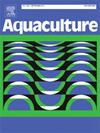丝状真菌白僵菌变种(PEKILO®)作为大西洋鲑鱼(Salmo salar)饲料中的新型蛋白质来源对环境的影响
IF 3.9
1区 农林科学
Q1 FISHERIES
引用次数: 0
摘要
本研究调查了大西洋鲑鱼(Salmo salar)前栓鱼饲喂含有丝状真菌白僵菌(Paecilomyces variotii,PEKILO®)的日粮在温室气体(GHG)排放、经济鱼进鱼出比率(eFIFO)、废物产出和食物-饲料竞争等方面对环境的影响。为此,使用四种实验日粮进行了饲喂试验。对照组日粮以鱼粉、大豆浓缩蛋白和小麦麸质粉为基础。日粮 1、2 和 3 的配方中,变异褐藻分别取代了对照日粮中 5%、10% 和 20% 的粗蛋白(CP)含量,这些粗蛋白主要来自鱼粉、大豆浓缩蛋白和小麦麸皮粉。日粮中添加变异褐藻会影响模拟环境指数,如温室气体排放量(P < 0.001);该指数与变异褐藻的剂量有关,负线性模型显示了这一点(P < 0.001,调整R方 = 0.96)。从膳食中摄入变异褐藻与 eFIFO 呈负相关(P < 0.001,调整后的 R 平方 = 0.82)。日粮中添加变种褐藻可减少日粮中的食物竞争饲料(FCF)(P <0.001)以及生产一公斤大西洋鲑鱼所需的 FCF 量(P <0.001)。与对照组日粮相比,喂食 3 号日粮的鱼类固体氮废物产量(以克/千克-1 鱼产量表示)增加了(P < 0.0001)。相反,以克/千克鱼产量表示的固体磷、镁和钾废物的线性减少(P < 0.0001)与日粮中添加变异褐藻的增加有关。同样,溶解氮、镁和钾(P< 0.0001)废物也随着变异褐藻取代对照日粮中 CP 含量的增加而线性减少。根据这项评估,变异鲤是大西洋鲑鱼饲料中一种对环境影响较小的相关替代蛋白质来源。未来大西洋鲑鱼的新型饲料应扩大使用生态足迹小的富含替代蛋白质和脂质的材料,这些材料是根据循环生物经济原则生产的,并利用变异褐藻等非食品竞争性饲料(NFCF),以推动该行业实现可持续发展。本文章由计算机程序翻译,如有差异,请以英文原文为准。

Environmental impacts of the filamentous fungi Paecilomyces variotii (PEKILO®) as a novel protein source in feeds for Atlantic salmon (Salmo salar)
The present study investigated environmental impacts associated with greenhouse gas (GHG) emission, economic Fish in Fish out ratio (eFIFO), waste outputs, and food-feed competition of feeding diets containing the filamentous fungus Paecilomyces variotii (PEKILO®) to Atlantic salmon (Salmo salar) pre-smolts. To achieve this, a feeding trial was conducted using four experimental diets. The control diet was based on fishmeal, soy protein concentrate, and wheat gluten meal. Diets 1, 2, and 3 were formulated so that P. variotii replaced 5, 10, and 20 % of the crude protein (CP) content of the control diet originating mainly from fishmeal, soy protein concentrate, and wheat gluten meal. Dietary inclusion of P. variotii affected simulated environmental indices such as GHG emission (P < 0.001); this index was P. variotii-dose-dependent, as illustrated by negative linear models (P < 0.001, adjusted R-squared = 0.96). Dietary inclusion of P. variotii was negatively correlated with eFIFO (P < 0.001, adjusted R-squared = 0.82). Dietary inclusion of P. variotii reduced food-competition feedstuff (FCF) in the diets (P < 0.001), as well as the amount of FCF to produce one kg of Atlantic salmon (P < 0.001). Relative to the control diet, solid nitrogen waste output, expressed as g kg−1 fish produced, was increased (P < 0.0001) in fish fed Diet 3. Conversely, linear decreases in solid phosphorous, magnesium and potassium (P < 0.0001) wastes expressed as g kg−1 fish produced were associated with increasing dietary inclusion of P. variotii. Likewise, linear decreases in dissolved nitrogen, magnesium, and potassium (P < 0.0001) wastes were observed with increasing replacement of the CP content of the control diet with P. variotii. Based on this assessment, P. variotii is a relevant alternative protein source with a low environmental footprint for use in Atlantic salmon feeds. Future novel feeds for Atlantic salmon should expand the use of alternative protein- and lipid-rich materials with a low ecological footprint that are produced according to a circular bioeconomy principle and utilize non-food-competing feedstuff (NFCF) such as P. variotii to move the industry towards sustainability.
求助全文
通过发布文献求助,成功后即可免费获取论文全文。
去求助
来源期刊

Aquaculture
农林科学-海洋与淡水生物学
CiteScore
8.60
自引率
17.80%
发文量
1246
审稿时长
56 days
期刊介绍:
Aquaculture is an international journal for the exploration, improvement and management of all freshwater and marine food resources. It publishes novel and innovative research of world-wide interest on farming of aquatic organisms, which includes finfish, mollusks, crustaceans and aquatic plants for human consumption. Research on ornamentals is not a focus of the Journal. Aquaculture only publishes papers with a clear relevance to improving aquaculture practices or a potential application.
 求助内容:
求助内容: 应助结果提醒方式:
应助结果提醒方式:


